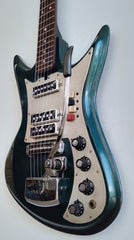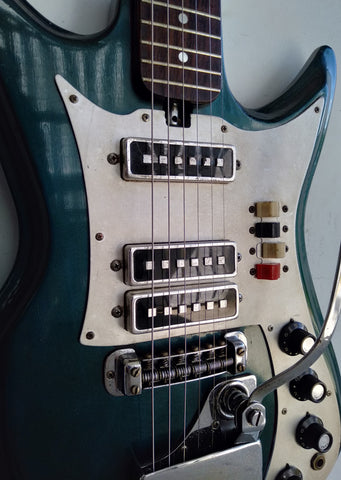Teisco K3L
Share
While I've written a couple of blogs about the bass version and the re-issue of the K series Teiscos, and LOTS of blogs on other Teiscos, it seems I've neglected one of my all time favourite vintage Teisco shapes, until now.

Introduced in 1966 to bring in a new era of adventurous designs for Teisco, the K series was a radical and forward thinking leap in design. Replacing what was a fairly conservative catalogue of "Fenderish" style and inspired guitars and basses, the K series was a completely new look with it's slightly outward pointing horns as used on Teiscos "tulip" shapes like the ET200. The K series horns were less extreme but much more aesthetically pleasing and somehow looked new and fresh while being familiar at the same time.

The body is solid timber and has a slight German carve that varies as it traces around the perimeter of the body. Moving from concave to convex carves with a large radius curve on the back. The body also has typical for the time neck support sides on each side of the pocket. These were considered "cheap" by some but are far less intrusive to playing as one might expect and really support the neck while being set out quite far for a bolt on.


The necks on these are thin and comfortable. Gone are the big baseball bats of earlier Teiscos and Guyatones and these have what most would consider to be small necks in width and depth. The fretboards are rosewood and all have a zero fret as standard.


The K series guitars came in 3 variants with their model number designating how many pickups were attached, The K2, K3 and K4 were all exactly the ame body and neck and similar in spec although the 3 and 4 got the upmarket bridge and vibrato while the 2 had the same as the cheaper standard Teiscos they also shared pickups with.

These pickups are some of my favourite vintage Japanese pickups with great output and frequency response. These square pole pickups have become quite revered over recent years for their tone, and with good reason.

The electronics allow each pickup to be turned on or off individually, along with a volume for each and master tone control. There's also a RHYTHM/SOLO switch which sends the signal through a cap for different tones.


These early examples here still have the plain aluminium scratchplate which was being phased in in 1965 and most K series guitars have the later stripped plate that Teisco are famous for.

The maple necks have the now famous 4/2 hooked headstock which again, is one of my personal favourites and trussrod adjustment at the body end without removing any plates or pickups. Both of these examples here still have their very sought after metal Teisco badge still intact.


The K2 was 16.000JY new and the K4 was 19.800, making it fairly high end in the standard Teisco catalogue at the time. These are really nicely made and great looking guitars that 55 years later still play and look great with many still being in all original and completely playable condition. As I always say, any 50+ year old guitar that is all original and playing condition is surely the sign of a well designed, well made guitar.

The K series guitars here are the inspiration for a new TMI Custom I'm currently working on. While it's not an exact copy (there's a couple of people making them) it is heavily influenced but with a real Tym twist.
